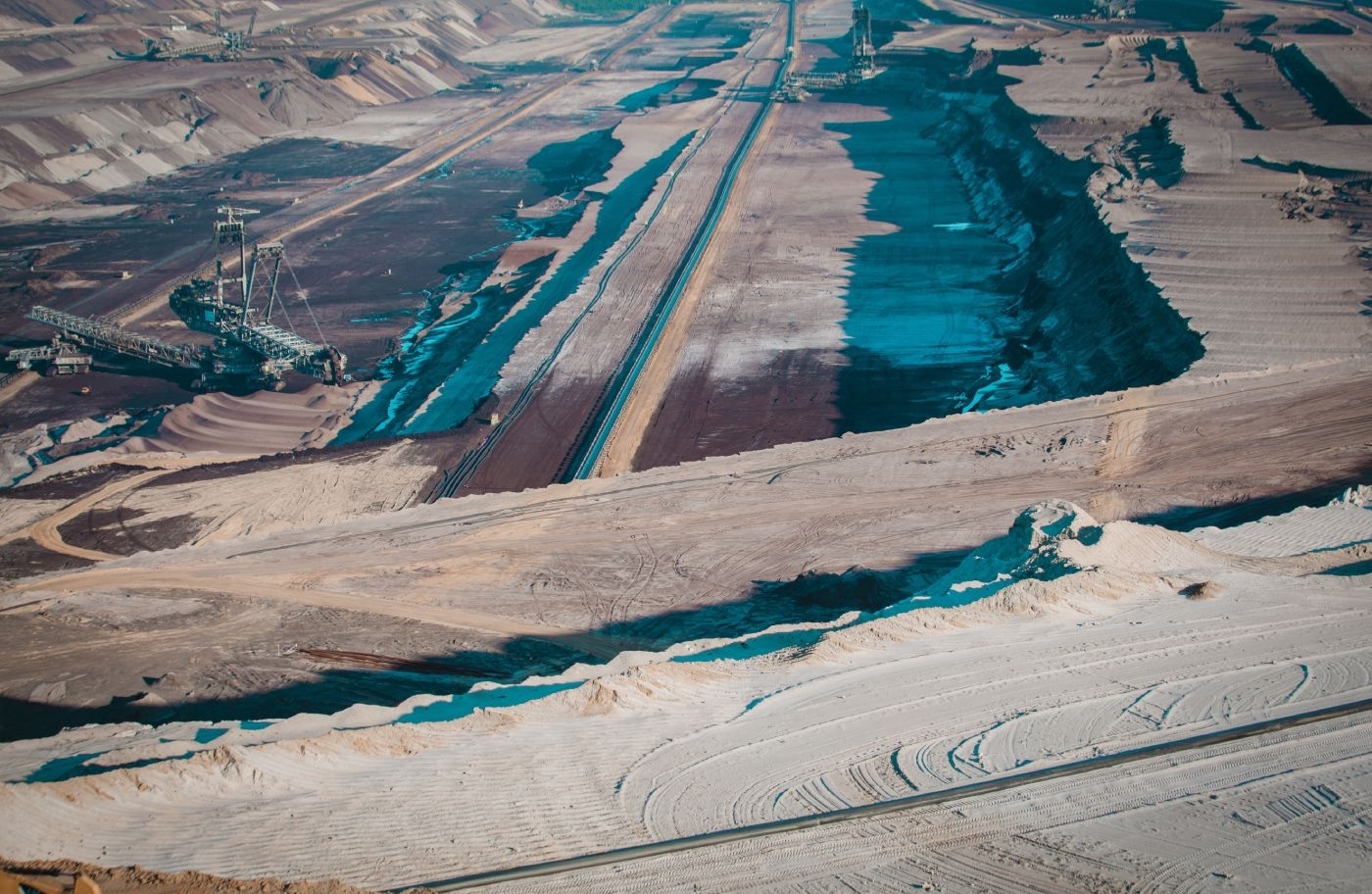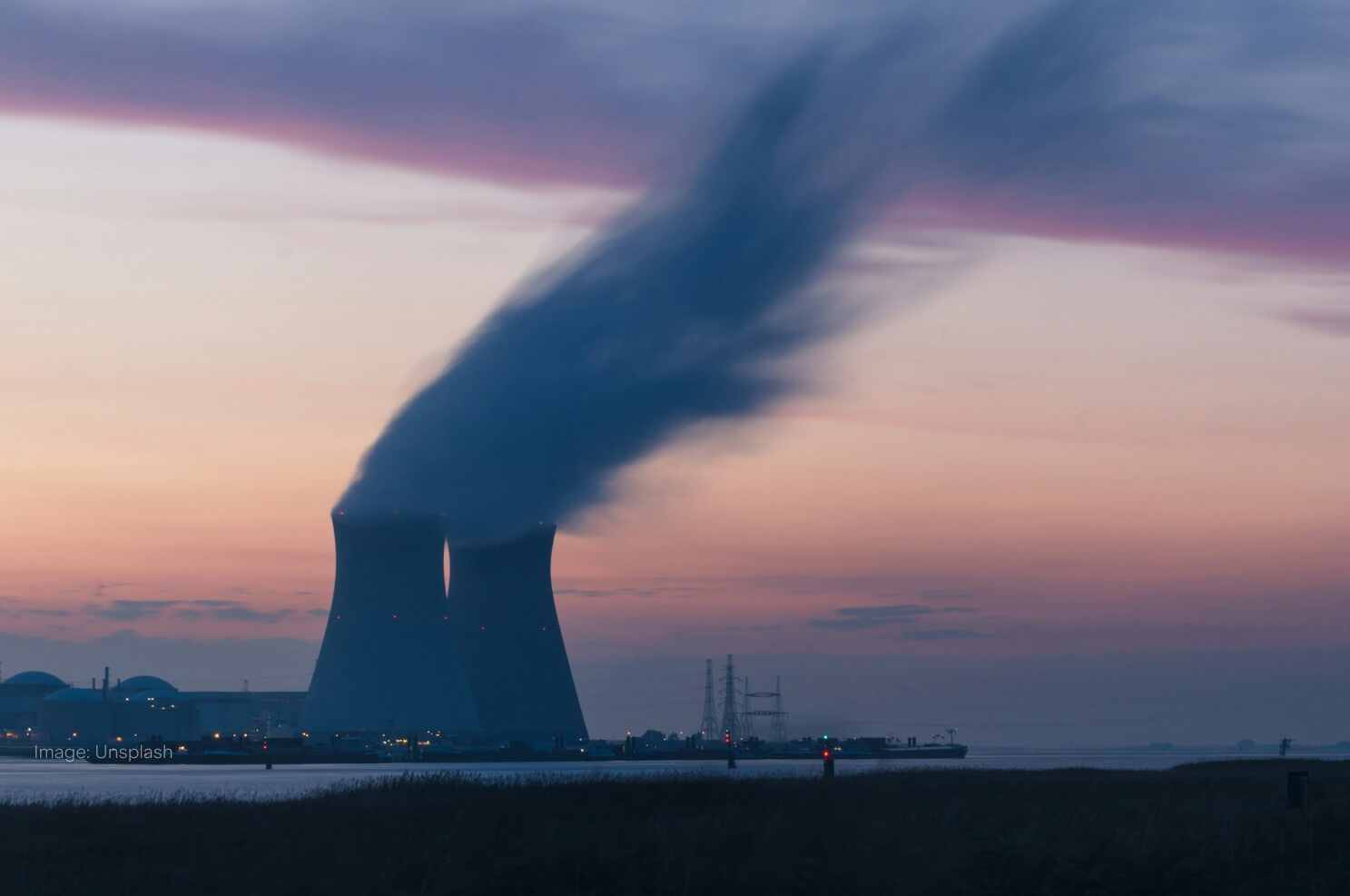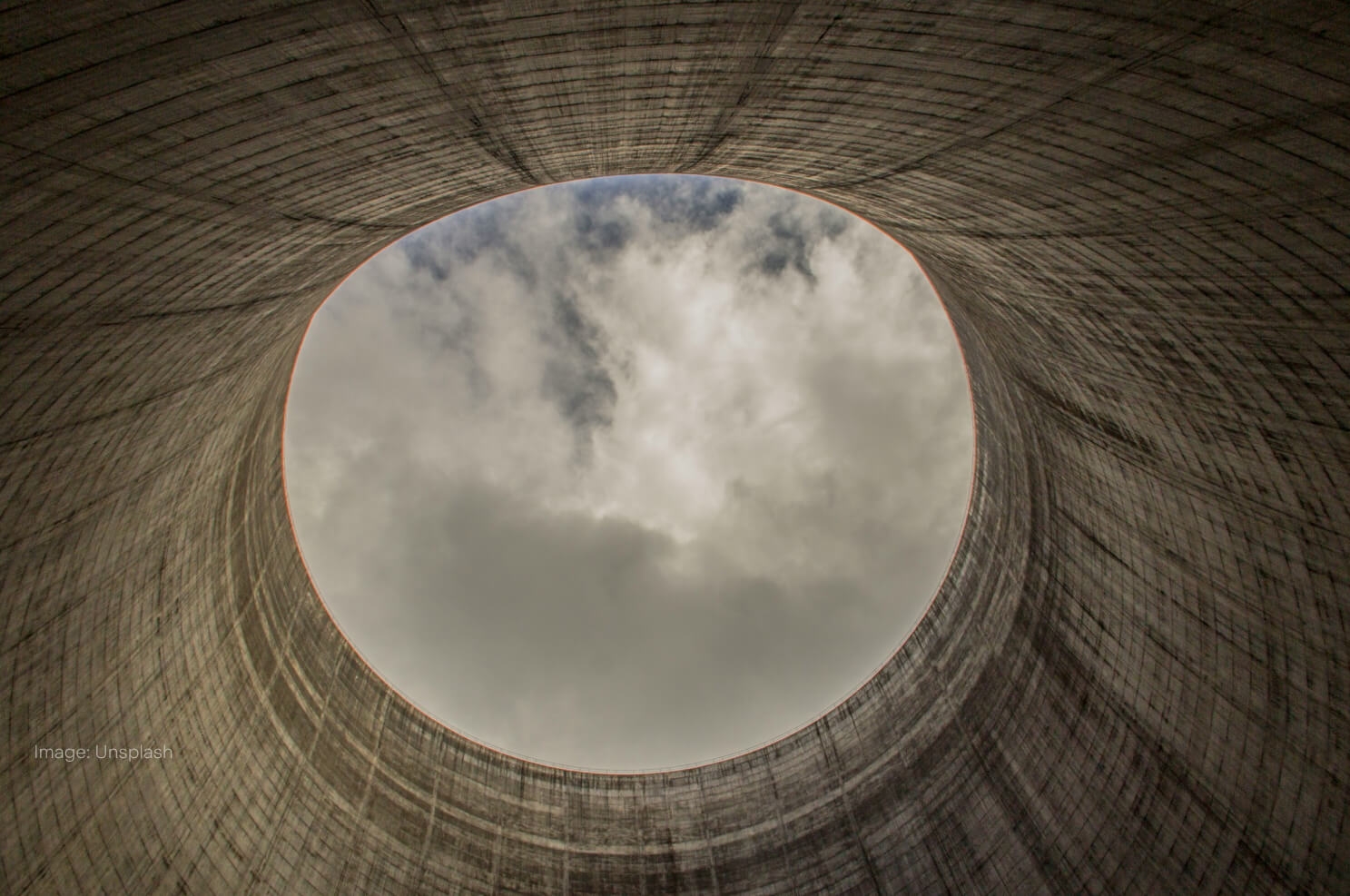
Are these the best nuclear energy ETFs? [2025]
As a low-carbon energy source that can operate 24/7, nuclear power is a vital technology in moving away from fossil fuels. In fact, the International Energy Agency expects global nuclear capacity to double by 2025.
Decide which are the best nuclear power ETFs to watch
Company Name | Ticker | Share Price | 1Y Return | AUM | Expense Ratio |
|---|---|---|---|---|---|
Global X Uranium ETF | US$26.06 | -3.41% | US$3.3b | 0.69% | |
Sprott Uranium Miners ETF | US$36.31 | -23.06% | US$1.4b | 0.75% | |
VanEck Uranium and Nuclear ETF | US$83.69 | +18.83% | US$1.1b | 0.61% | |
Sprott Junior Uranium Miners ETF | US$16.99 | -27.86% | US$233.9m | 0.80% | |
Range Nuclear Renaissance Index ETF | US$45.25 | +72.58% | US$234.8m | 0.85% | |
Direxion Daily Uranium Industry Bull 2X Shares | US$15.75 | -38.14%* | US$7.7m | 1.44% | |
Themes Uranium & Nuclear ETF | US$29.85 | +8.39%* | US$5.2m | 0.35% | |
Defiance Daily Target 2X Long Uranium ETF | US$10.95 | -46.72%* | US$3.9m | 0.95% |
Data as of 21 February 2025. Source: Stake, Google Finance.
*URAA, URAX, and URAN returns are since inception, as these funds have been trading for less than one year.
The list of ETFs mentioned is ranked by assets under management. When deciding what ETFs to feature, we analyse the company's financials, recent news, advancement in their timeline, and whether or not they are actively traded on Stake.
Get started with Stake
Sign up to Stake and join 750K investors accessing the ASX & Wall St all in one place.
Discover if these nuclear ETFs are the right investment for you
1. Global X Uranium ETF ($URA)
Global X’s flagship uranium ETF is the most popular nuclear fund on the market, holding US$3.3b in assets. This fund offers broad exposure across the nuclear energy and uranium value chain.
Top holdings include Cameco Corp ($CCJ) and NexGen Energy ($NXE). The former is a large, well-established uranium producer, while the latter is a junior miner focused on developing the Rook I site in Canada.[1] URA also holds a significant position in the Sprott Physical Uranium Trust, which tracks uranium spot prices.
The fund has an expense ratio of 0.69% and tracks the Solactive Global Uranium & Nuclear Components Total Return Index. The fund has a one-year return of -4.72%, driven by lower uranium prices.

2. Sprott Uranium Miners ETF ($URNM)
The Sprott Uranium Miners ETF focuses specifically on uranium miners, including both senior and junior firms. The fund’s largest holding is in Cameco Corp, the world’s largest publicly listed uranium producer. URNM also holds a sizeable position in Kazatomprom, the national uranium mining company of Kazakhstan.
Like URA, URNM holds a stake in the Sprott Physical Uranium Trust, which helps the fund better track uranium spot prices. URNM follows the North Shore Global Uranium Mining Index and has an expense ratio of 0.75%. Over the past year, the fund has fallen 25.30%, with miners particularly exposed to falling uranium prices.
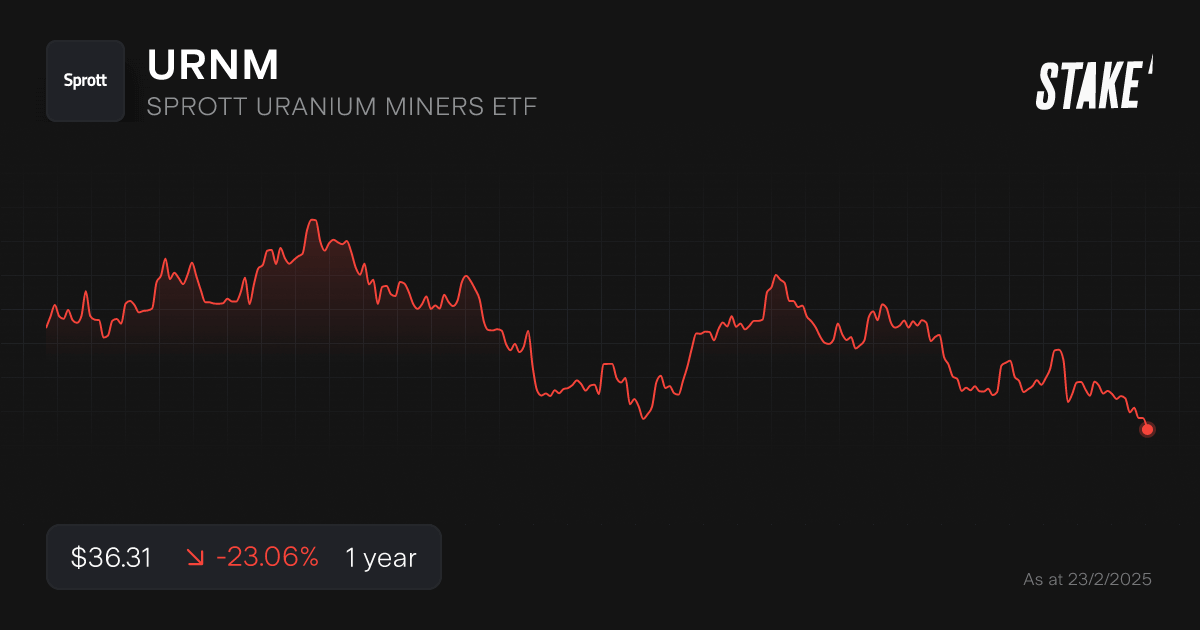
3. VanEck Uranium and Nuclear ETF ($NLR)
VanEck’s ETF offers slightly broader exposure than competing nuclear funds. NLR tracks the MVIS® Global Uranium & Nuclear Energy Index, which includes firms that earn at least half of their revenue from uranium and nuclear energy. That means the fund can include companies that are not exclusively focused on nuclear power.
For example, two of NLR’s largest holdings are Constellation Energy ($CEG) and PSEG ($PEG), both of which are traditional utility companies in the U.S.
Although this broader focus makes NLR less of a pure-play nuclear ETF, it could offer greater diversification. NLR has an expense ratio of 0.61% and returned 19.00% over the past year.
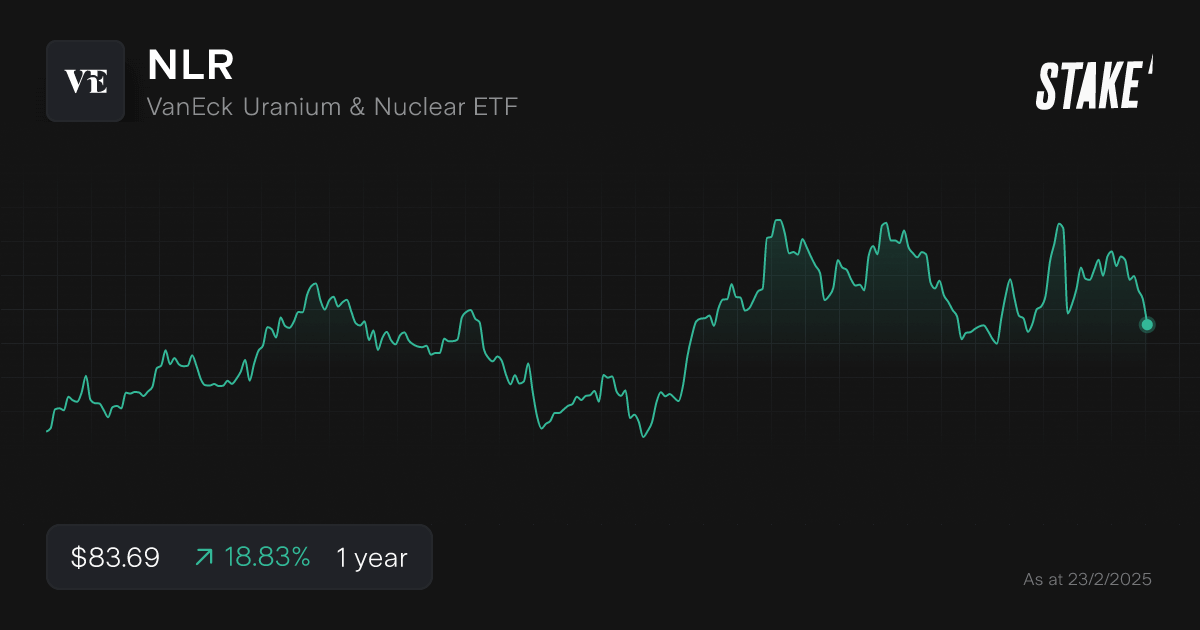
4. Sprott Junior Uranium Miners ETF ($URNJ)
Sprott’s second uranium ETF focuses specifically on junior miners. Junior miners are smaller companies in the exploration and development stage of resource extraction. Currently, URNJ’s top holdings are Paladin Energy ($PDN), Uranium Energy Corp ($UEC), and NexGen Energy ($NXE).
Investing in junior miners is an inherently speculative endeavour. This ETF could be a good fit for an investor with a high risk profile and is willing to endure greater volatility for potentially higher rewards. URNJ declined by 29.26% over the past year and has a 0.80% expense ratio.

5. Range Nuclear Renaissance Index ETF ($NUKZ)
Posting a 76% gain over the past year, NUKZ is the best-performing nuclear ETF on our list. The fund has particularly benefited from a large position in Oklo Inc. ($OKLO), a California-based nuclear technology company whose stock has soared more than 250% over the last 12 months.
Range’s fund tracks a custom index that aims to reflect the nuclear industry as a whole. Besides Oklo, the ETF’s largest holdings include Cameco ($CCJ) and Constellation Energy ($CEG). NUKZ is also notable for its 58% exposure to the United States, since nuclear funds typically have Canada as their largest geographic exposure.
NUKZ could be a good fit for an investor who wants to back American nuclear technology, particularly the development of advanced reactors. The fund’s expense ratio is slightly higher than peers at 0.85%.

6. Direxion Daily Uranium Industry Bull 2X Shares ($URAA)
URAA is a leveraged ETF designed to offer 2x exposure to the daily performance of the Solactive United States Uranium and Nuclear Energy ETF Select Index. This index features many of the companies already mentioned, including Cameco, NexGen, Kazatomprom, and Sprott’s physical trust.
Like any leveraged ETF, URAA carries unique risks. Most notably, the fund should not be expected to return twice the index for any period longer than a day. Moreover, ‘volatility drag’ will likely impair performance for long-term holders.[2]
Although URAA is not an investing tool, it could be useful for short-term traders looking to speculate on the uranium market. The ETF has a 1.44% expense ratio.

7. Themes Uranium & Nuclear ETF ($URAN)
URAN is a relatively new fund, having only listed in September 2024. The ETF’s key advantage is a remarkably competitive expense ratio of 0.35%. URAN’s fee is far lower than any other ETF on this list.
The fund follows the BITA Global Uranium and Nuclear Select Index, which aims to track the nuclear value chain globally. URAN’s top holdings include Constellation Energy, Cameco, and American Electric Power ($AEP). This ETF could be a good fit for an investor who seek broad exposure to the nuclear industry while keeping fees as low as possible.

8. Defiance Daily Target 2X Long Uranium ETF ($URAX)
URAX is a 2x daily uranium bull ETF, similar to URAA. The two funds differ slightly – while URAA tracks the leveraged performance of an underlying index, URAX tracks the URA ETF. In practice, the difference is unlikely to be significant.
URAX could have a slight advantage thanks to a lower expense ratio of 0.95%. This ETF should be treated as a day-trading instrument, for more advanced day traders with a high risk profile. It is not suitable for buy-and-hold investors.

What is the best-performing nuclear ETF?
The best-performing nuclear ETF in recent history has been $NUKZ.
This ETF posted a 76.16% gain over the past year, largely driven by investments in advanced reactor development. Whether NUKZ can sustain this performance will depend on the commercial viability of technologies like small modular reactors (SMRs).[3]
Unfortunately, many nuclear ETFs have had disappointing recent performances. Falling uranium prices have been particularly detrimental to mining firms, especially junior miners. Nuclear energy continues to have long-term tailwinds, so this recent performance may not be indicative of future returns.
What are some nuclear energy stocks?
There are a wide range of nuclear energy stocks on the market, including firms across the industry’s value chain:
- Cameco Corp ($CCJ): Cameco is the world’s largest public uranium production company. In 2022, the Canadian firm produced about 12% of the world’s uranium. Cameco is notable for operating the McArthur River/Key Lake facility, the world’s largest high-grade uranium mine. Learn more about Camceo in Under the Spotlight.
- NexGen Energy ($NXE): NexGen is a junior miner aiming to develop the massive Rook I uranium site in Canada. At full capacity, Rook I could be one of the world’s largest low-cost sources of uranium. Despite trade tensions, NexGen has already signed supply deals with U.S. companies.[4]
- Oklo Inc. ($OKLO): Oklo is a California-based company attempting to commercialise small modular reactor technology. Although the firm went public via SPAC in 2024, Oklo is not expected to deploy a functional reactor until at least 2027. Sam Altman, OpenAI CEO, was an early backer of the company and currently serves as Oklo’s chairman.
Looking for companies in Australia with exposure to nuclear energy? There are several listed on the ASX, including Paladin Energy ($PDN), Boss Energy ($BOE), and Deep Yellow ($DYL).
✅ Related: Discover the best Australian uranium stocks→
Why is nuclear becoming more popular?
Nuclear is becoming more popular as an energy source in the global shift from fossil fuels.
Like renewable energy, nuclear does not emit carbon during the energy generation process. Unlike renewable energy, nuclear energy can be run 24/7 – it does not depend on the sun shining or the wind blowing.
Still, there are valid criticisms of nuclear energy. Byproducts like radioactive waste can be hazardous, and there are substantial embodied emissions in the nuclear plant construction process. The disasters which have happened in the past like Chernobyl and Fukushima create understandable trepidation.
Overall, nuclear looks set to be an increasingly important part of a post-fossil fuel energy mix. That’s especially true as technologies like AI drastically increase global energy demand.
Disclaimer
The information contained above does not constitute financial product advice nor a recommendation to invest in any of the securities listed. Past performance is not a reliable indicator of future performance. When you invest, your capital is at risk. You should consider your own investment objectives, financial situation and particular needs. The value of your investments can go down as well as up and you may receive back less than your original investment. As always, do your own research and consider seeking appropriate financial advice before investing.
Any advice provided by Stake is of general nature only and does not take into account your specific circumstances. Trading and volume data from the Stake investing platform is for reference purposes only, the investment choices of others may not be appropriate for your needs and is not a reliable indicator of performance.
$3 brokerage fee only applies to trades up to $30k in value (USD for Wall St trades and AUD for ASX trades). Please refer to hellostake.com/pricing for other fees that are applicable.
Article sources
[1] NexGen's Rook I uranium project to now cost US$1.6 billion
[2] Return stock and volatility drag
[3] Oklo’s nuclear order book shows potential of small reactors
[4] NexGen Nears Deals to Sell Uranium to US Utilities Despite Trade Tensions
